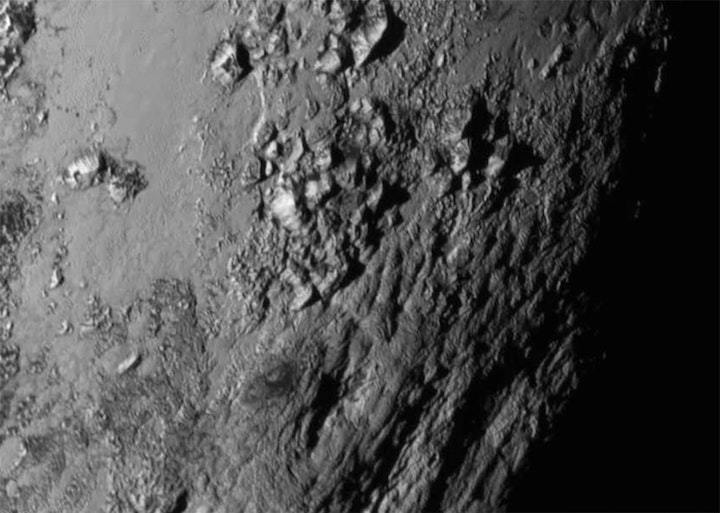25.03.2018
Research suggests a mountain range moved on top of nitrogen ice. Richard A Lovett reports.

Giant mountains of ice up to 5000 metres tall may have broken off the rim of Pluto’s Sputnik Planitia and “sledded” 100 kilometres into the basin on a slippery slope of nitrogen ice, scientists say.
Sputnik Planitia is a 1000-kilometre-wide depression discovered by NASA’s New Horizons spacecraft. It is surrounded by mountains made of rock-hard water ice, but those on its western side are weirdly chaotic and jumbled, says Sean O’Hara, a planetary geology graduate student at the University of Illinois at Chicago.
“They don’t quite look like mountains anywhere else in the Solar System,” he says.
What formed them has been something of a mystery.
Superficially, they look somewhat like icebergs in a sea of frozen nitrogen. And while frozen nitrogen is solid, it is capable of flowing, slowly.
This means the mountains could have moved to their present locations, exactly like icebergs.
“It’s possible they could have floated, because water ice is less dense than nitrogen ice,” O’Hara says.
But there’s a catch. “These are very large,” he says.
And since the vast majority of an iceberg is beneath the surface, for these mountains to be floating, the nitrogen beneath them would have to be very deep.
“You would need a ridiculous amount of nitrogen,” O’Hara notes.
Could they instead have been dragged to their present locations by flowing nitrogen, even though their bases were scraping across on bedrock (or, in the case of Pluto, “bed-ice”)?
Not likely, O’Hara said at the recent 2018 Lunar and Planetary Science Conference in The Woodlands, Texas. In his models, flowing nitrogen couldn’t come “even close” to producing enough force to do the job.
But it is possible, he tells Cosmos, for these mountain blocks to have slid down a giant incline, lubricated by an underlying layer of nitrogen ice. Using “very reasonable” figures for the slope of the incline — comparable to those observed on the edges of other large impact basins, he says, “you can reach a reasonable amount of lubrication to move a very large block, just under its own weight.”
In fact, he says, he found that these blocks could have moved from their likely sources to their present locations in as little as 100 years. “[That’s] astoundingly fast on a geologic time scale,” he adds.
The mental image of what may have happened is stunning, O’Hara says, invoking a vision of five-kilometre-tall mountains sliding downhill at speeds of up to a kilometre a year.
“Once the basin shallows out and they run out of steam,” he adds, “they just stay where they are.”
How long ago it happened is a mystery. It probably didn’t occur super-early in Pluto’s past, because Sputnik Planitia is almost certainly an ancient impact basin that would not initially have been filled with nitrogen ice.
Also, the blocks appear to have broken off a fracture zone created by the expansion of Pluto’s crust as its subsurface oceans froze and expanded. That would have created giant cracks in its surface — possibly well after the impact that created the planitia.
But eventually, O’Hara says, enough nitrogen ice would have formed in the basin to infiltrate the cracks between the blocks and set them in motion.
The best earthly analogue, he says, might be the collapse of a giant ice sheet, such as Antarctica’s Larsen B shelf, where in a single month in 2002, 3250 square kilometres of ice splintered and flowed out to sea in a stream of giant icebergs.
“That was water ice and liquid water, whereas what we see on Pluto was water ice and nitrogen ice,” he says. “And there are certainly quibbles on that as an exact analogy. But I think it is a really interesting thought-analogy between similar geological processes on completely opposite ends of the solar system.”
Francis Nimmo, a planetary scientist at the University of California, Santa Cruz, US, who was not part of the study team, is impressed. Another study presented at the same conference, by William McKinnon of Washington University in Missouri, US, he says, found that other processes on Sputnik Planum could be explained if the base of its nitrogen glacier is “free slip” — meaning that it is well-lubricated.
“This is a nice tie-in with the ice-block presentation,” Nimmo says. “Overall, the story seems quite plausible — the blocks could have moved fast.”
Trying to figure out how the mountains of Sputnik Planitia were formed is important, O’Hara adds, not only because they are one of the solar system’s most spectacular features, but because similar processes might have occurred on Neptune’s moon Triton, and possibly on other Kuiper Belt objects like Ultima Thule, which the New Horizons spacecraft will be visiting in January, 2019.
“You need to consider both classic geological processes and these ices that serve as geological materials in very cold environments that are not well understood,” O’Hara says.
Quelle: COSMOS
